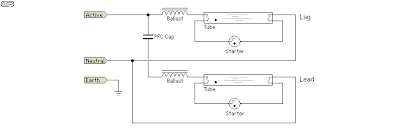Fluorescent Tube Basics
While they have been with us for many years, fluorescent lamps remain somewhat mysterious to most people. This isn't really surprising, since their operation isn't simple. The tube itself contains a mixture of gases, but the active ingredient is mercury. When operated as an arc, mercury vapour emits a vast amount of short-wave ultraviolet light. This is invisible, but phosphors on the inside of the tube itself fluoresce when struck by UV, and are designed to emit visible light. Most of the remaining UV light is absorbed by the glass, which is opaque to ultraviolet (this is why you can't get a suntan from behind a glass window). Refer to Figure 1 to follow the explanation. This also shows a representation of the fitting that was used for the illumination tests. For all tests, only the centre tube was installed, with the others removed to ensure that each lamp was operating under near identical conditions.
Figure 1 - Wiring Diagram For a Conventional "Troffer" (Fluorescent Light Fitting)
In order to start the arc inside the tube, a starter is used. This is a small neon lamp, with a bimetallic strip contact mechanism built in. When power is first applied, the neon conducts a small current - enough to heat the bimetallic strip, and this causes the switch to close. Once closed, current flows through the filaments at each end of the tube via the ballast, bringing them to working temperature. The ballast limits the current to a safe value. The filaments themselves are fairly rugged, and are typically around 2 Ohms resistance each.
While the switch in the starter is closed, there is no current flow through the neon gas in the starter. The bimetal strip cools and the contacts open. When current drawn through an inductor is suddenly interrupted, a high voltage is generated as the magnetic field collapses. This high voltage will (hopefully) strike the arc in the tube. As most people will have noticed, fluoros usually flicker a few times when turned on. This is usually because the initial strike is insufficient to maintain the arc because the gas temperature is too low. After a few strikes, the temperature is high enough that the arc maintains itself. Maximum light output is usually not achieved for around 5 minutes, but the difference is not very noticeable with tubes in reasonably good condition.
Once the arc is struck (and maintained), the ballast has a new task. An arc has negative resistance, so as the voltage across the tube falls, the current increases. The ballast limits the current to a safe value, as determined by the tube's ratings. With a continuous arc, the voltage across the tube is too low to allow the neon gas in the starter to conduct, so the starter is effectively bypassed. Old tubes will often be unable to maintain an arc, and this is why they flash and flicker, with the starter constantly opening and closing because the arc is not self-sustaining. Since AC is applied to the tube, the arc actually stops and re-strikes on each half cycle, causing the light to flicker at 100 (or 120) Hz. This is normally not visible, but a tube at the end of its life may only conduct fully in one direction. This causes a 50/60Hz flicker that is often visible and annoying to some people.
Because the ballast is an inductor, it should dissipate no power, but this can never be the case in reality. Inductors are wound with copper wire, which has resistance. If nice thick wire were used, this resistance could be minimised, but to do so is very expensive. A compromise is reached where ballast losses are deemed "reasonable", and cause the temperature rise due to power loss to remain within allowable limits. New regulations will soon specify the maximum allowable power loss in ballasts, which will see a return to larger (and more expensive) types than we commonly see today.
Finally, a capacitor is (or should be) installed in parallel with the incoming mains. This is sized to suit the ballast inductance and supply frequency. The capacitive reactance of the PFC (Power Factor Correction) cap should exactly balance out the inductive reactance of the ballast. If this is done properly, the power factor will be 1 - a perfect result. This cannot happen with a fluorescent lamp though, because the current drawn is not linear. The voltage across the tube is a reasonable approximation to a squarewave because of the arc characteristics, and the maximum achievable power factor is normally around 0.9 (90%). Typical fittings manage 0.85 or so (some are better than others).
This means that the current drawn from the mains will be 10% higher than necessary to produce the lamp's rated power. This means that for a 36W fluorescent lamp, the minimum attainable current will be around 190mA at 230V because of ballast losses. The ideal current (if power factor correction were perfect) would be 174mA, allowing for a total typical load of 40W.
Figure 1A - Wiring Diagram For a "Lead-Lag" Fluorescent Fitting
For many commercial and industrial installations, the 'lead-lag' circuit shown above is common. By including the power factor correction cap in series with one of the ballasts, the power factor is brought to around 0.85 as with the approach shown above, but the capacitor is smaller and thus cheaper than would be the case if the ballasts were in parallel.
Note that where 120V (60Hz) mains voltages are used, you may find that ballast is actually an auto-transformer. This is used because the voltage is not quite high enough to ensure reliable operation, and the auto-transformer configuration boosts the voltage. Figures 1 and 1A are for fittings operating from 220-230V, which need no voltage boost for normal operation. Predictably, the circuits for auto-transformer ballasts are different from those shown here, but similar techniques are used.
.jpg)


Post a Comment for "Fluorescent Tube Basics"
Dont use outgoing links!